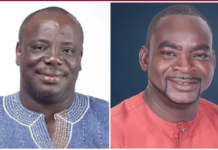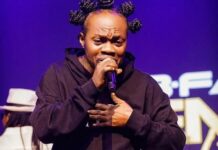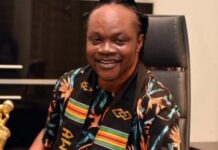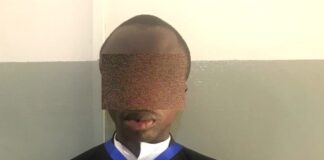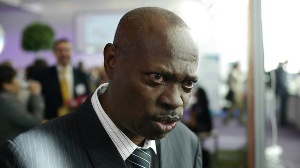
It has emerged in court that the COCOBOD Committee, which was chaired by Dr Yaw Adu-Ampomah, whose report formed the basis for the prosecution of Dr Stephen Opuni and businessman Seidu Agongo, was constituted after EOCO informed Dr Adu-Ampomah that a test result by the Ghana Standards Authority has proven that lithovit is indeed a fertilizer.
The committee, which sat for days, also invited several people but failed to invite the suspects—Dr. Opuni and Mr. Agongo—even though the committee’s final report indicted the two.
Also, the committee excluded the test result conducted by GSA with all parties involved, which showed that lithovit contains the necessary ingredients to qualify it as fertilizer. The report rather added two disputed reports—one by the Chemistry Department of the University of Ghana and the other by GSA—taken from samples Dr Adu-Ampomah submitted to EOCO for testing from an unknown source that said lithovit was negative for fertilizer.
Mr. Paul Agyei Gyang, who led the EOCO’s team that investigated the alleged fraudulent procurement of lithovit involving the accused between 2014 and 2016 as the Head of Organised Crime Unit, revealed in court on Wednesday, February 21, 2024, that the test that showed a positive result for lithovit was duly communicated to Dr Adu-Ampomah, who was the complainant in the fraud allegation, months before the committee the latter headed was formed.
Interestingly, while the COCOBOD committee began to investigate the procurement of lithovit on October 4, 2017, EOCO was still investigating the same product as was requested by the chairman of the committee, Dr Adu-Ampomah, who was also then the Deputy Chief Executive of COCOBOD in charge of Agronomy and Quality Control.
The EOCO investigations continued until they were ordered to hand over the docket to the Ghana Police Service on June 15, 2018.
However, Mr Agyei Gyang confirmed to the court that the EOCO investigating team was not aware of the work of the COCOBOD committee, nor was it informed about the report of the Adu-Ampomah committee, dated November 7, 2017, which was tendered in evidence by the prosecution as exhibit H.
According to the lead investigator, he only heard about the committee for the first time in court.
Mr Gyang, who is now at the Operations Directorate of EOCO as a senior staff, confirmed to the court as a subpoenaed witness for the second and third accused on February 19, 2024, that Dr Adu-Ampomah accompanied his complaint with samples of lithovit, whose source was unknown.
He reiterated on February 21, 2024, that because of the differences in the two reports, though conducted by the same institution, the Ghana Standard Authority, the scientists who worked on the samples were invited by EOCO, after which Dr. Adu-Ampomah was also invited and informed about the outcome.
According to Mr Gyang, the first test conducted by GSA that produced a negative outcome for lithovit was done at the Cosmetics Drugs Forensic and Toxicology Department, which was not equipped to test fertilizer. EOCO received the test results on May 5, 2017.
Seidu Agongo, whose company, Agricult Ghana Limited, produces the lithovit fertilizer, rejected the report when he was invited by EOCO, prompting the need for a second test to be carried out on the instructions of the then-Executive Director of EOCO, with the involvement of all interested parties. A sample for the test was therefore taken from the COCOBOD warehouse at Spintex and submitted to GSA on June 30, 2017.
EOCO received the result for the second test on July 2, 2017.
This time, the test was done at the Material Science Department of GSA, which is known to be responsible for testing fertilizers.
The head of the Material Science Department of GSA, Mrs Baah Mantey, wrote in her statement to investigators that, from the second scientific report, “the results revealed that that sample contained some amounts of nitrogen, phosphorus and potassium, and so the sample was identified as fertilizer.”
“Please tell the court if you know. Was the complainant informed about the result of the second test?” Benson Nutsukpui asked the EOCO investigator.
“Yes, my Lord, as I told the court about the people, he himself was equally informed,” the witness replied.
Read excerpts of the proceedings on February 21, 2024
Q. Who was the complainant in the matter that was brought before EOCO?
A. My Lord, if my memory serves me right, deputy chief executive in charge of agronomy and quality control. In the person of Dr. Adu Ampomah.
Q. When you said that your executive director had discussions with the deputy chief executive- agronomy and quality control- on the second test, who was that person who was the deputy chief executive- agronomy and quality control- at COCOBOD then?
A. My Lord, it is Dr Adu Ampomah
Q. You also told this court that after you received the second report, the directorate brought the scientists together; that is correct?
A. Yes, my Lord, that is correct.
Q. Who else was in this discussion with the scientists?
A. My Lord, the head of the chemistry department of the University of Ghana
Q. And any other person?
A. That is all I can remember for now.
Q. Sir, did the directorate of EOCO have the occasion to communicate this second test to other interested parties?
A. My Lord, if anything of that happened, it should be at the management level of which I may not be privy.
Q. Please tell the court if you know. Was the complainant informed about the result of the second test?
A. Yes, my Lord, as I told the court about the people, he himself was equally informed
Q. Was he invited?
A. Yes.
Q. To where?
A. To EOCO office.
Q. What was he invited to the head office for?
A. My Lord, as an interested party, it was only reasonable that management invited him to let him know what the results were
Q. Sir, cast your mind back, this invitation to Dr. Adu Ampomah, was it on or before your meeting with the scientists?
A. I think initially, the scientists were invited to explain the reason they had two different results. I think thereafter, some few days or so, he was also invited.
Q. Can you recall around what date the scientists were invited?
A. It’s unfortunate, my Lord, I can’t recall
Q. Please look at exhibit H, page 3, just at the top, the first two lines, the executive summary; it says that a committee was constituted in October 2017; that is correct?
A. Yes, my Lord.
Q. Please what date was that committee constituted?
A. From the report October 4, 2017.
Q. As of October 4, 2017, this matter was under investigation by EOCO
A. Yes, my Lord.
Q. Tell this court on that date, October 4, 2017, did you receive the second report of the testing at EOCO?
A. Yes, My Lord, the second report came in somewhere in June or July 2017
Q. Sir, what is the date of that report exhibit 133?
A. July 26, 2017.
Q. So, as of October 4, 2017, EOCO has received this report?
A. Yes, my Lord
Q. And also discussed it with the scientists as of October 4, 2017
A. Yes, my Lord
Q. From the nature of the operations of EOCO how long after July 26, 2017, EOCO would have to inform the interested parties the results of the second test?
A. By our operations, as soon as the report comes, parties have to be informed.
Q. So tell this court by October 4, 2017, was Dr Adu Ampomah informed about the result of the second test?
A. I believe so, my Lord.
Q. You have exhibit H, look on the cover; it is dated November 7, 2017; that is correct?
A. Yes, my Lord, that is correct.
Q. Look at page 106 of Exhibit H. The two reports from the standards authority and the University of Ghana, which concluded that Lithovit they examined did not have the necessary ingredients are in that report, which is Exhibit H; that is true?
A. Yes, my Lord, it is true
Q. Take some few minutes and glance through and see if the report exhibit 133 A2/A3 (the second test result from Ghana Standards Authority) is in it or captured in exhibit H
A. My Lord, after having a cursory look at the document, it is not there; I only found the first report from Ghana Standards Authority, which was forwarded to EOCO on June 5, 2017, and another cover letter from the University of Ghana Chemistry Department.
Q. After your cursory look at exhibit H, you found that exhibit 133 is not in it; that is correct?
A. Yes, my Lord, exactly so.
Q. And look at page 3 of Exhibit H, and tell this honourable court who is the chairman of the committee that produced Exhibit H?
A. My Lord, Dr Adu Ampomah, deputy chief executive- agronomy and quality control- was the chairman.
Q. At all times that EOCO was doing [an] investigation into this matter, who was their contact point, or who were they reporting to at COCOBOD?
A. Dr Adu Ampomah.
Q. Tell this honourable court if, back in 2017, you personally or the investigative team knew about the existence of this committee.
A. My Lord, I’m for the first time hearing of this committee. I can’t tell if management was informed.
Q. EOCO handed over the docket to the police in June 2018. Is that the case?
A. My Lord, the docket was handed to the police, but I can’t remember whether June or July.
Q. But can you remember the year?
A. Somewhere in 2018 or 17, there about,
Q. Yesterday, we talked about the investigator’s statement you wrote. Was the handing over the docket earlier or after the investigator’s statement you wrote?
A. My Lord, the statement was together with the docket.
Q. If I told you that your statement was written on June 15 2018, when would you have handed over the docket?
A. 2018, my Lord
Q. By the time you were handing over the docket to the police, did EOCO receive that report, exhibit H on EOCO’s file?
A. My Lord, the investigative team did not receive anything like that; I don’t know if management did.
Q. By the mode of operations in EOCO, if management received a copy, would it be minuted down to the investigating team?
A. Exactly so, my Lord.
Q. What documents were handed over to the police from EOCO?
A. My Lord, we had directive to hand over all dockets involving COCOBOD cases of which this docket was part, and in this docket, complainant, witnesses and suspects and all relevant documents which we have gathered, including test reports, i.e. the three test reports received from the scientists.
Q. So, EOCO would consider exhibit 133 relevant on the docket?
A. yes, my Lord, you are right.
Q. On March 15, 2021, under cross-examination, Mr Thomas Prempeh Mercer told the court that the docket that the police received had only two test reports, the ones that had only negative results. Would that be correct?
A. My Lord, I would be surprised.
Q. I know you would be surprised, but I’m asking if EOCO did not give the police exhibit 133.
A. My Lord, the report was inclusive
Q. Mr Thomas Prempeh Mercer indeed admitted reading your investigator’s statement; tell this honourable court: did he or anybody on the police investigative team contact you to find out about exhibit 133, which you wrote about in your statement?
A. No, my Lord, nobody contacted me.
Q. From June 2018 till today, you have remained in the employment of EOCO that is correct?
A. Yes, my Lord.
Q. Has your office sent you any signal or notice to request an explanation as to why exhibit 133 not being on the police docket?
A. My Lord, nobody has contacted me.
Q. In the normal cause of investigation, an investigator’s statement, which you wrote, would be the beginning of the investigative work of the one taking over
A. Yes, my Lord, you are right
Q. And in normal investigative work, if you wrote about another test result and if it can’t be found, you would be contacted. That is also true?
A. Ye, my Lord.
Q. Can you explain how come you were never contacted in respect of investigations you did and exhibit 133?
A. My Lord, it would be very difficult for me to explain
Q. Tell this court what is your impression about this development in relation to exhibit 133 that I have taken you through this morning?
A. My Lord, as I have told this court, I’m only surprised, but I can’t explain
Q. Sir, EOCO took statements from a lot of people; that is correct?
A. That is correct.
Q. Sir, cast your mind back to [the] file you took statements from people?
A. Yes, my Lord, a lot of people.
Q. And it included farmers?
A. Yes, my Lord.
Q. Would the name Obeng Emmanuel or Emmanuel Obeng come to mind?
A. The name I might have forgotten, but we had interactions with farmers
Q. Do you remember the number of farmers you took statements from?
A. The farmers we took statements from, we had them through Dr. Adu Ampomah
Q. When you say you had them through Dr Adu Ampomah, what exactly do you mean?
A. It means my Lord, he mentioned them as those people we could contact
Q. Did the investigative team make any request to A2 and A3 to bring you farmers who used the product?
A. My Lord, I don’t think we did
Q. Apart from Dr. Adu Ampomah’s witnesses, did the investigative team find farmers on your own to question about the product?
A. I think so
Q. Can you remember how many you got?
A. My Lord, two or three
Q. Did you take statements from them?
A. Some we contacted said they were scared to give statements, some did not give statements. We had statements from about two or three, if my memory serves me right
Q. Can you remember whether two or three were the ones you got through Dr Adu Ampomah or not?
A. My Lord, I can’t remember
Q. As an investigative team, how often are your meetings with Dr Adu Ampomah?
A. My Lord, as the deputy executive director in charge of agronomy and quality control, most of the time, he was dealing directly with the executive director of EOCO; we would only go there when there was the need and directives given to us
Q. How many times did you have directives as an investigative team you went there as an investigative to meet Dr Adu Ampomah during the course of this investigation?
A. My Lord, we were not dealing with this case; we were dealing with about 8 different dockets involving COCOBOD, so when there is a directive to meet him on any of those dockets, we did, not only on this docket.
Q. On all these, how often would you say during the course of the investigation you were seeing Adu-Ampomah?
A. My Lord, I can’t remember.
Q. Of the 8 cases that you were investigating, how many are being prosecuted?
A. I can’t be very sure about it.
Q. But this is the only one you [know] at this time?
A. For that matter, this is the only one I know.
Q. Do you know whether DSO Akrasi gave a statement to the police?
A. My Lord, he was invited to assist the new team which took over from us, so I won’t be surprised if he gave a statement.
Q. If he did, in whose custody would it be?
A. It would be in the custody of the police.
Q. Would EOCO have a copy?
A. I can’t tell my Lord.
Q. Would Akrasi report to EOCO his involvement with the police team?
A. Yes, my Lord, he has to report to EOCO
Q. And would you, as the team leader, be briefed on it?
A. My Lord through the briefing that is why I got to know that he was invited to assist the police
Q. On February 8 2021, Chief Inspector Prempeh told the court that he had a petition to investigate this matter and that the petition was signed by the Senior Minister, Hon. Yaw Osofo Marfo. Did EOCO also receive a petition to deal with this matter
A. No, my Lord.
Q. After you gave your statement and handed over the docket, were you ever involved in the investigation on lithovit fertilizer?
A. No, my Lord
Q. Was EOCO, your institution, involved in any further investigation on this matter?
A. No, my Lord, EOCO was not involved
Q. Is there anything else you know about this investigation that I have not asked you about?
A. No, my Lord
Benson: My Lord, that would be all for the witness
Source: Ghanaweb


